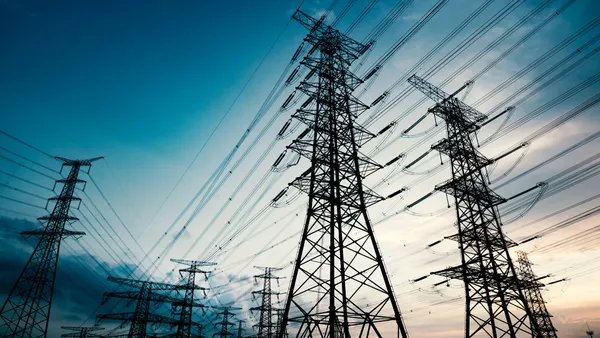Dive Brief:
-
Pacific Gas & Electric and a group of its bondholders that were attempting to take over the company's reorganization process have reached an agreement, the utility announced on Wednesday, paving the way for it to exit bankruptcy.
- Per the agreement, which requires approval from the U.S. Bankruptcy Court for the Northern District of California, the bondholder committee will withdraw its competing reorganization plan and throw its support behind PG&E's own restructuring proposal instead.
-
The deal brings PG&E a lot closer to emerging from bankruptcy, Jared Ellias, professor at University of California, Hastings College of the Law, told Utility Dive. But PG&E still faces a huge obstacle: the criticisms of California Gov. Gavin Newsom, D, who reiterated his objections to the company's reorganization plan in a filing with the bankruptcy court on Wednesday.
Dive Insight:
PG&E has been trying to fend off attempts by its bondholders to wrest control of the company since last summer. In September, the ad hoc committee of senior unsecured noteholders filed a competing reorganization proposal for PG&E that was also endorsed by the committee representing Northern California wildfire victims — one of the most significant creditor groups in PG&E's Chapter 11 bankruptcy.
But in December, PG&E and the wildfire victims' committee reached a $13.5 billion settlement to resolve individual claims stemming from the 2015 Butte Fire, 2017 North Bay wildfires and the 2018 Camp Fire. The agreement marked a significant milestone in the company's reorganization proceeding, coming after a $11 billion settlement with a committee of insurance companies holding wildfire claims against PG&E and a $1 billion agreement with a group of local government entities affected by the fires.
The agreement with the bondholders' committee was "inevitable" after the wildfire victims teamed up with PG&E, according to Ellias, since U.S. Bankruptcy Judge Dennis Montali — who is overseeing PG&E's reorganization — has been very deferential to the victims' committee.
"[The bondholders] are not as interested in fighting this alone. If they still had the support of the fire victims, they'd have a decent chance of winning the bankruptcy — but they aren't going to without it," he said.
The agreement between PG&E and the bondholders resolves conflicts over pre-petition funded debt — essentially, what rates the bondholders will be paid and what notes will be refinanced. If approved by the bankruptcy court, PG&E will issue new notes that "will save the company's customers approximately $1 billion," according to a press release.
"Over the last several months, we made significant progress in our Chapter 11 cases. We have settled with all pre-petition wildfire victims' groups — individuals, insurance companies and public entities — and we've now reached an agreement with the bondholder group. We remain focused on working with key stakeholders, including elected officials and our state regulator, on how PG&E will look, act, and be held accountable as we emerge from Chapter 11," parent company PG&E Corp. CEO and President Bill Johnson said in the release.
But PG&E still faces one large obstacle on its path out of bankruptcy: Gov. Newsom, who in December penned a letter to the company's executives stating that its proposed reorganization plan doesn't comply with Assembly Bill 1054, legislation passed by California in 2018.
AB 1054 created a state wildfire insurance fund, and laid down several conditions for PG&E to be able to participate in it: The company needs to exit bankruptcy by June 30, with a reorganization plan that aligns with state climate goals, does not increase ratepayer costs, and results in a governance structure that can address its track record with safety issues.
Newsom's lawyers filed another objection with the bankruptcy court on Tuesday, noting that despite numerous discussions with PG&E's advisors since December, the utility has not amended its plan to meet these requirements. It seems clear that PG&E is instead trying to "leverage the chapter 11 process to force" the CPUC and the state to approve "a sub-optimal plan," they wrote.
Newsom is "pursuing strategies to protect California's interests through further intervention, including a state takeover of the utility," according to the filing.
Newsom's disapproval could stall PG&E's exit from bankruptcy, according to Ellias, since the CPUC is yet to determine that the company's plan complies with AB 1054. The CPUC is reviewing the issue under a separate proceeding.
"You have a lot of people locked into this deal, so it's hard to do that much for the governor," he said, adding that this might force the company to start from scratch.
The official creditors' committee in PG&E's bankruptcy case is reviewing the new agreement and will "look forward to working with all parties to reach a final resolution that treats all parties fairly and equitably and ensures access to safe, reliable and affordable access to electricity to all Californians," according to a statement.
Mindy Spatt, communications director with ratepayer advocacy group The Utility Reform Network, told Utility Dive in an email that the organization agrees with Gov. Newsom that PG&E needs to do better, and that the state should consider taking over the utility if it can't. TURN is particularly unimpressed by the proposal's inclusion of $1 billion in financing fees "and the empty promise of that amount of savings to customers further down the line," she added.
"Putting investors first is the cause of many of PG&E's problems, not the solution," she said.














